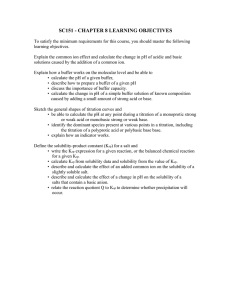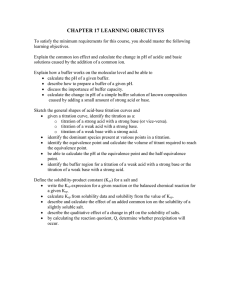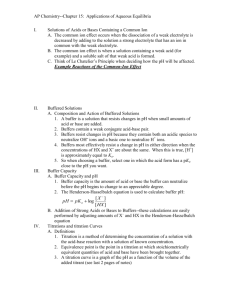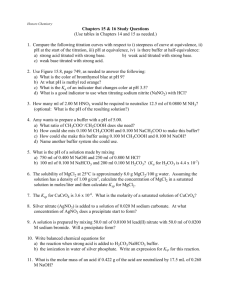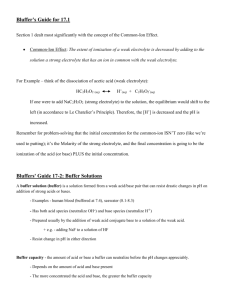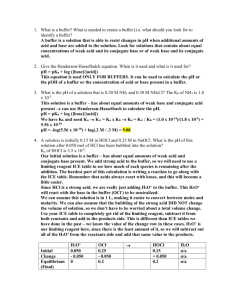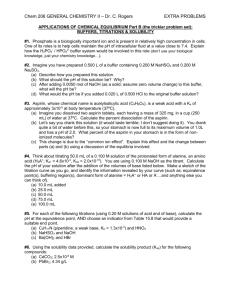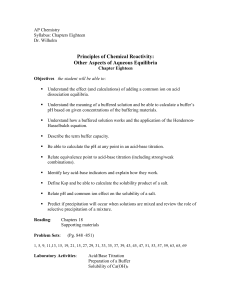Text Questions
advertisement
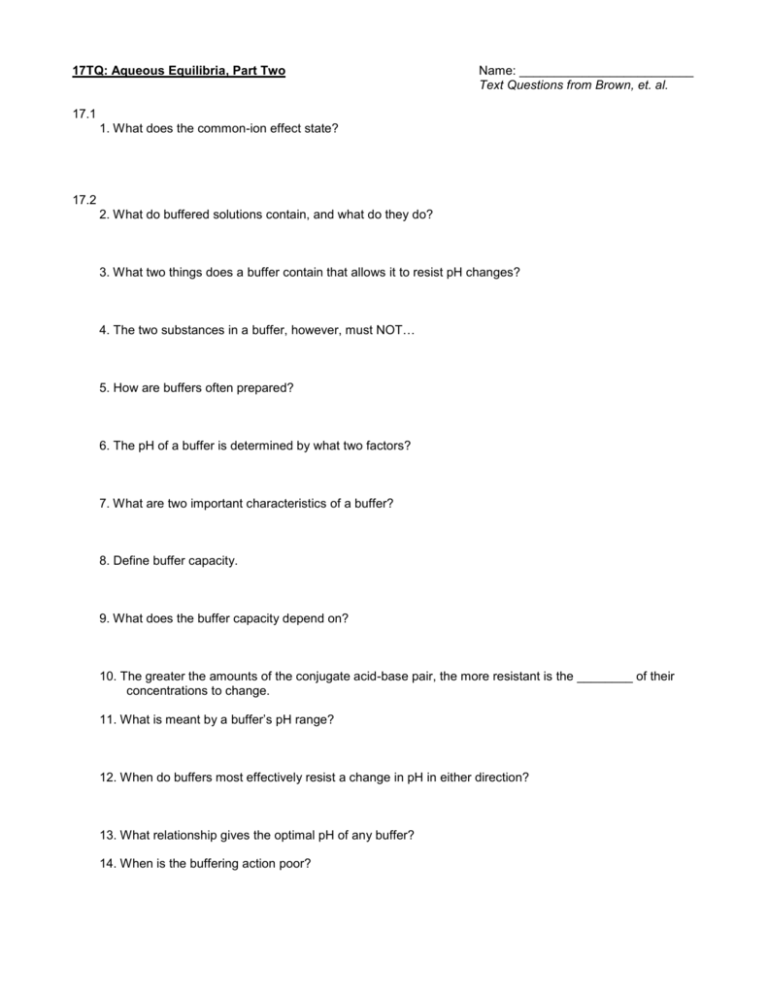
17TQ: Aqueous Equilibria, Part Two Name: _________________________ Text Questions from Brown, et. al. 17.1 1. What does the common-ion effect state? 17.2 2. What do buffered solutions contain, and what do they do? 3. What two things does a buffer contain that allows it to resist pH changes? 4. The two substances in a buffer, however, must NOT… 5. How are buffers often prepared? 6. The pH of a buffer is determined by what two factors? 7. What are two important characteristics of a buffer? 8. Define buffer capacity. 9. What does the buffer capacity depend on? 10. The greater the amounts of the conjugate acid-base pair, the more resistant is the ________ of their concentrations to change. 11. What is meant by a buffer’s pH range? 12. When do buffers most effectively resist a change in pH in either direction? 13. What relationship gives the optimal pH of any buffer? 14. When is the buffering action poor? 15. What is the typical usable range for a buffer? 16. When we add a “strong” to a buffer, what can we assume? 17. After adding a “strong,” what two steps must you take when determining a buffer’s new pH? 17.3 18. What is the equivalence point of a titration? 19. The shape of the titration curve makes it possible to determine what three things? 20. For “strong-strong” titrations, how do you determine the initial pH? 21. Draw a sketch of a titration in which a strong base is added to a strong base. Draw in and label the location and pH of the equivalence point. 22. When does the pH change very rapidly? 23. What kind of indicator will give a sufficiently accurate measure of the volume of titrant needed? 24. List two indicators that are appropriate to use for a “strong-strong” titration. 25. For “weak-strong” titrations, how do you determine the initial pH? 26. For a weak acid-strong base titration, the pH at the equivalence point is _______ 7 because… 27. Why is the choice of indicator for “weak-strong” titrations more critical than for “strong-strongs”? 28. Sketch the titration curve for H3PO3 and label the various species. 17.4 29. What kind of predictions can we make by considering solubility equilibria? 30. What is a saturated solution? 31. What does the solubility product indicate, and how is it denoted? 32. In general, what does the solubility product equal? 33. What does a small value of Ksp indicate? 34. The solubility-product constant (i.e., ____) is the equilibrium constant between… 17.5 35. What happens to the solubility of a slightly soluble salt if a second solute with a common ion is present? 36. If a compound contains the anion of a ______ _____, such as F – from CaF2 or CO32– from CaCO3, its solubility will __________ as the solution becomes more acidic. This is because more acidic solutions contain more available H+ ion, which will draw the anion out of the crystal to form the weak acid. 37. Q36 listed two anions that can appear in slightly soluble salts. Write the formulas and names for three other such “basic anions.” 38. What is a characteristic property of metals? 39. Transition-metal ions, in particular, can also interact with… 40. Why does AgCl (which has a very small Ksp) dissolve in the presence of aqueous NH3? 41. What condition must be met for a Lewis base (other than water) to increase the solubility of a metal salt in aqueous solution? 42. What is a complex ion? 43. The solubility of a metal salt _________ in the presence of suitable Lewis bases – such as ____, ____, or ____, if the metal forms a __________ with the base. 44. Amphoteric oxides and amphoteric hydroxides are capable of what? 45. List the formulas and names of four metal ions whose oxides and hydroxides are amphoteric. 46. Why is Al3+(aq) more accurately represented as Al(H2O)63+(aq)? 47. What is the common practice in writing out reactions involving Al(H 2O)63+ and similar species? 17.6 48. Equilibrium can be achieved by starting with what? 49. A. If Q > Ksp, there are too many “free-floating” ions; ______________ occurs. B. If Q = Ksp, ____________ exists (i.e., we have a ____________ solution). C. If Q < Ksp, more solid __________. 50. Ions can be separated from each other based on what? 17.7 51. Before the advent of modern analytical instrumentation, mixtures of metals were analyzed using ____ ____________ methods. 52. What is the difference between qualitative analysis and quantitative analysis? 53. When performing qualitative analysis, WHAT is important? 54. List the formulas and names of the common metal ions that form insoluble chlorides.
